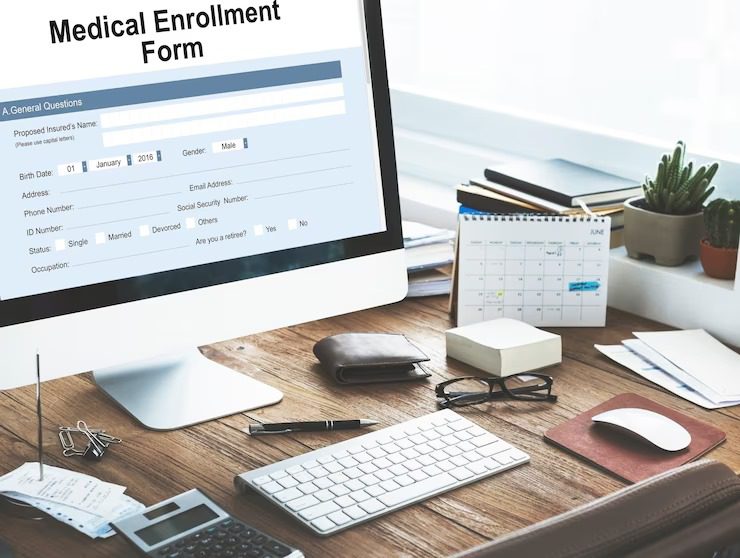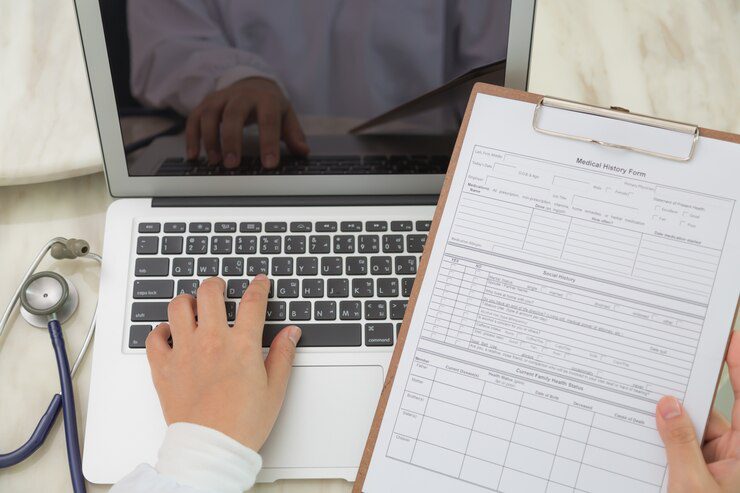Processing of Medical Claims
Medical Billing The Comprehensive Guide, which is informative and comprehensive for medical coders of all backgrounds.
This article covers everything from basic medical terms to the intricacies of the CPT and ICD-10 code
systems. You will gain knowledge of the many healthcare industries in which medical regulators work, understand how regulation impacts medical costs, and learn how to adapt to medical compliance and
ever-changing regulations.
Medical Coding
At its most basic, medical coding such as translation. The role of the coder is to convert anything written
in some form—a prescription for a particular drug, for example—into a letter or number code as
accurate as possible Treatment of any medical condition, diagnosis, and treatment each has a rule.
There are thousands and thousands of codes for diagnosis, clinical treatment, and treatment. Let’s start
with a simple practical medical coding illustration.
Procedure
- A patient arrives at the doctor’s office with profuse coughing, sneezing or fever. After asking the patient
about his symptoms and doing some preliminary tests, the doctor examines the patient and makes a
diagnosis. - Each part of this session is recorded by a physician or other staff member in the health care provider’s
office. The medical coder is responsible for converting all relevant data from the patient visit into
alphanumeric codes used in the billing process. - A medical code writer needs to know many different types of codes and many subcategories, but for the
purposes of this example we will focus on two: the International Classification of Diseases, or ICD, code
for patient, and Current Procedure Steps, or CPT , rules of thumb These codes are the common language
of doctors, hospitals, insurers, and insurers. - The clerk codes each case after reviewing the medical provider’s report of the patient’s visit. Every
aspect of this plan, including the patient’s symptoms, the doctor’s evaluation, and the doctor’s
diagnosis, is recorded. - Every coding set has its own guidelines and conventions. Some indicators, like those of previous
infections, might be presented chronologically. Whether the code was written appropriately and
whether each code’s unique requirements were met will determine how the case turns out. - When the medical coder gives the form or software application the proper code, the coding process is
finished. Reports are coded and then expire.

FEATURED ONLINE MEDICAL CODING PROGRAMS
Medical Billing
Medical billing is basically as easy as it sounds: after receiving the data from the medical coder,
medical billers create a claim, or bill, for the insurance company.
Of course, nothing about the health care system is as easy as it looks, even when it comes to this
process. Let’s go back to our prior example to gain a better understanding of medical billing. The same
patient is coughing up a lot of mucous and has a fever. This patient makes an appointment with
the doctor over the phone. The process of billing for medical services starts here
Navigating the Medical Billing Process: From Code Reception to Patient Billing
- The medical biller may need to work with a collections agency to make sure the healthcare
provider is paid when a patient is behind on their payments or refuses to pay. - Therefore, the medical biller serves as a kind of intermediary between patients, medical professionals, and insurance companies. Like the coder, the biller can be thought of as a kind of translator; whereas the coder converts medical processes into codes, the biller does the same for
financial reports. For the time being, all you need to know is that the biller is responsible for
ensuring that the healthcare provider gets paid fairly for the services they offer. - Looking into a job in medical billing and coding is a great idea right now. The need for health
care workers who can handle critical data processing is increasing on a daily basis as the
American health care system is modernizing and a significant section of the population is
approaching retirement age. - From now until 2024, the medical billing and coding industry is predicted to rise by 15%,
according to the Bureau of Labor and Statistics. Over 30,000 positions will become available in
the next seven years. - Not only are there lots of employment available in billing and coding, but many of these
positions pay well. In 2016, the average pay for coders and billers was $38,040, or $18.29 per
hour when one is just beginning out. The yearly salary for the top 10% of programmers in the US
is $62,840, and in some states, that amount is significantly higher. - The aging of the population, the increased emphasis on health data and informatics, and the
digitization of medical records are the main causes driving the growth of the medical billing and
coding industry. Computer-savvy billing and coding specialists will have an advantage over
others as the health care system increasingly uses electronic health information. - Now let’s examine some of the regular duties carried out by medical coders and billers in the
industry. Remember that there are times when one individual fills both roles.
Medical Coding
Expert programmers examine the reports they need to code first thing in the morning. Their work is quite simple: after reviewing a physician’s report following an operation or examination, a coder decides how best to convert it into code. Annotation may indicate, for instance, that a patient went to the doctor complaining of a sore throat. The doctor suspected streptococcus, a common throat infection, after looking at the patient’s throat. The physician ran a quick strep test. The doctor diagnosed the patient with strep throat and gave them a prescription for amoxicillin, an antibiotic, to last for one week.
Coding Precision
 The coder would use the CPT and ICD-10-CM manuals to determine the appropriate way to document this diagnosis and procedure after reviewing this list. In this instance, the coder would document oral amoxicillin using CPT code 00781-6041, utilize ICD-10-CM code J02.0 for streptococcal sore throat, and use CPT code 87880 for quick strep testing. After entering the necessary code on a form or, more often, a computer program, the coder will go on to the next report. Reading the reports, turning them into relevant legislation, and implementing them will occupy the remainder of the day.
The coder would use the CPT and ICD-10-CM manuals to determine the appropriate way to document this diagnosis and procedure after reviewing this list. In this instance, the coder would document oral amoxicillin using CPT code 00781-6041, utilize ICD-10-CM code J02.0 for streptococcal sore throat, and use CPT code 87880 for quick strep testing. After entering the necessary code on a form or, more often, a computer program, the coder will go on to the next report. Reading the reports, turning them into relevant legislation, and implementing them will occupy the remainder of the day.
Mastering Routine Codes
Most coders get familiar with the codes for the more frequently performed operations in their particular offices, and most coding is rather simple. For example, a general practitioner’s coder will get rather acquainted with the codes for flu vaccines (90658) and general office visits (99214). The rules for each code must be followed by coders. For example, there are conditions that must be coded in a specific order.
However, there could be times when the code has a lot of ambiguity or gray areas. If the
ailments, symptoms, or treatments are more complex, the coding requirements may likewise
become more detailed and precise.
When consulting the relevant handbooks and their rules isn’t enough, most programmers will ask
the greater coding community for direction and advice.
Above all, the coder has to ensure that the diagnosis code and the operation code are the same. A
denied claim could occur if the specified operation does not make sense given the diagnosis,
which could seriously complicate the reimbursement process.
Finally, every medical practice has a different lag time for reporting codes. Usually, this lag
period lasts between two and five business days. In other words, coders have five days from the
surgery or doctor’s visit to finish their coding. Meeting these dates guarantees that the invoicing
and reimbursement procedure may proceed without hiccups. The coder bears the responsibility
of overseeing these deadlines and doing tasks promptly and effectively.
Medical Billing
 When the medical coder’s work concludes, the medical biller’s job begins. As per the instruction in Course 1-2, the medical biller bears the task of generating precise and lawful bills for the healthcare provider’s office and promptly forwarding them to the insurance company or payer. The billing specialist is also responsible for sending and receiving payments from patients. This is a condensed overview of the medical billing procedure. A medical biller’s day consists of several distinct procedures.
When the medical coder’s work concludes, the medical biller’s job begins. As per the instruction in Course 1-2, the medical biller bears the task of generating precise and lawful bills for the healthcare provider’s office and promptly forwarding them to the insurance company or payer. The billing specialist is also responsible for sending and receiving payments from patients. This is a condensed overview of the medical billing procedure. A medical biller’s day consists of several distinct procedures.
The medical biller is in charge of preparing formal, accurate claims, verifying transaction report accuracy, and preparing patient invoices. Initially, the medical biller generates a medical claim using the codes obtained from the medical coder, either electronically or through a form. A claim is an itemized list of procedures, services, and prices that a healthcare practitioner submits to a payer in an effort to get paid, as we discussed in the last course.
This process, while simple in theory, can be very complicated. First, the biller must confirm that all of the codes correspond to one another. Consider this a quality check after the medical coder completes their report. This requires the medical biller to be familiar not only with medical terminology, but also with the current forms of CPT, ICD and HCPCS codes. Medical billers must also become familiar with the patient’s insurance policy in order to determine if the procedures and services performed by the healthcare provider are covered by that patient’s plan. Essentially, the medical biller needs to make sure that each code, and thus each procedure, listed on the claim is actually billable.
Navigating Payer Policies
In most cases, this is determined by the payer and the agreement that the patient or healthcare
practitioner has with them. What can and cannot be invoiced for under the policyholder’s
contract is determined by a set of regulations or guidelines that are specific to each insurance
payer. Medical billers must prepare a claim that complies with the provider’s set rates because medical
facilities have varying prices for specific treatments. After keeping all of these factors in mind, the medical biller accurately prepares and submits a medical claim to the payer. A clearinghouse or the payer directly may receive the claim, depending on which payer the medical biller is sending it to.
“Medical Billing Vocabulary and Key Terms,” Section 3-2, will explain what a clearinghouse is.
For now, just be aware that certain clearinghouses and payers need particular software or
documents. For Medicaid, for instance, the claim needs to be submitted on a CMS-1500 form.
Payer adjudication is the process by which the payer conducts an assessment once a claim is
submitted. We’ll go into further detail about this procedure in Section 3. In essence, the payer
determines the portion of the bill it will pay the provider back for and returns it to them in the
form of a transaction report.
After then, the biller examines and verifies the accuracy of this transaction report. The biller
verifies that the payments and charges match the terms of the provider’s contract with the payer.
The biller then prepares a bill for the patient, explaining which services and procedures are
covered, how much they cost, and which ones the patient must pay for, if the transaction report is
accurate.
Conclusion
Collections is the latter part of a medical biller’s workday. A medical biller is responsible for
reminding patients who are unable or unwilling to pay for the treatments they received and, in
the worst case scenario, for forwarding their bill to a collections agency. Depending on the
policies of the healthcare provider, the collections procedure differs






